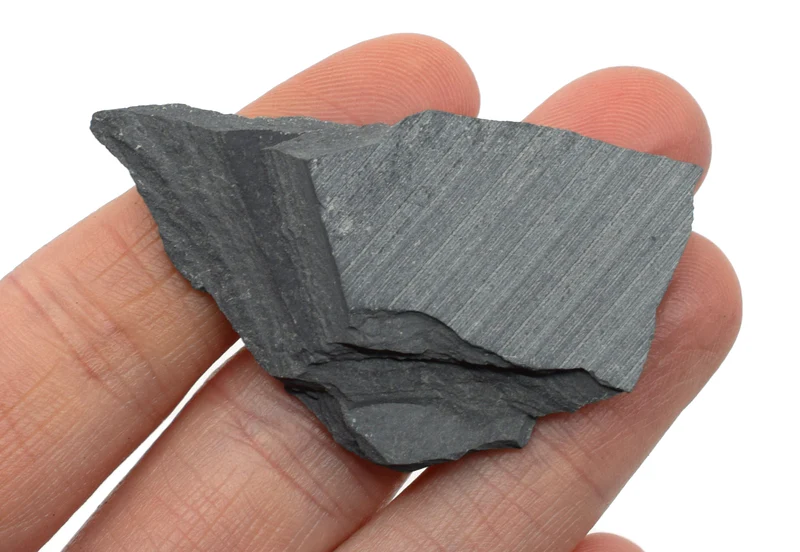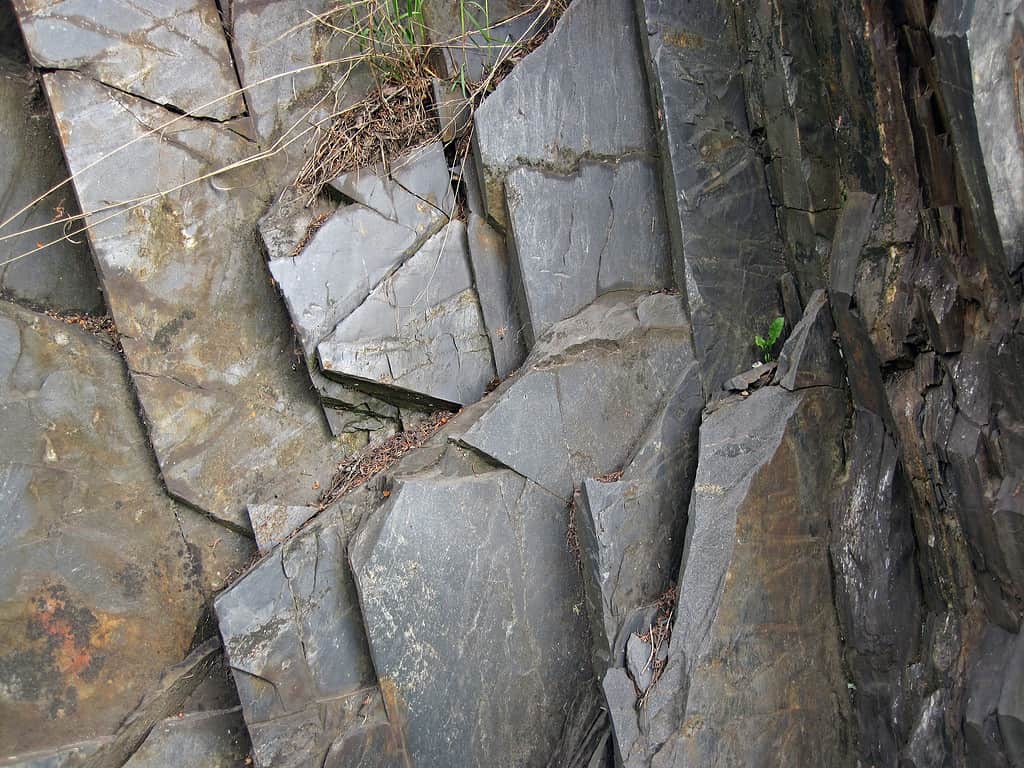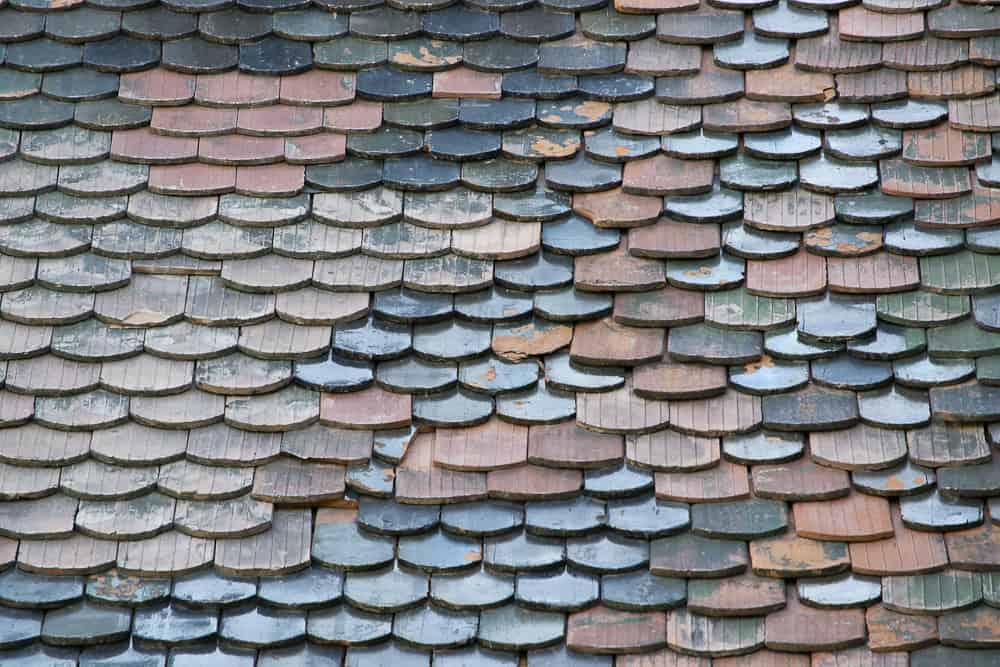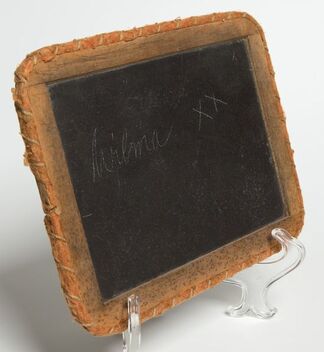
Slate is a fine-grained, durable metamorphic rock known for its ability to split into thin, strong slabs. It originates from sedimentary rocks like shale through a process of low-grade regional metamorphism, slate has a range of uses from roofing to flooring, owing to its excellent durability, as well as being water proof and an excellent heat insulator.
How Slate Forms

Slate is formed from sedimentary rock, typically shale or mudstone (fine particles of clay), sometimes mixed with volcanic ash. The transformation from sedimentary rock to metamorphic slate involves several key processes, each occurring under specific environmental conditions.
The process begins with the original clay or volcanic ash sediments, which are deposited and compacted over time to form shale or mudstone. As these sedimentary rocks are buried deeper into the Earth due to tectonic forces, they encounter increased pressure and slight rises in temperature. These conditions do not melt the rock but instead cause the minerals within the rock to realign and recrystallize.
One of the key features of slate’s formation is the development of a distinct foliation known as slaty cleavage. Unlike the bedding planes in sedimentary rocks, which form through the deposition of material, slaty cleavage forms perpendicular to the direction of compression. This reorientation is primarily due to the alignment of platy minerals such as micas and chlorite, which adjust to the directional stress by arranging themselves in planes that can easily split.
In some cases, the chemical composition of the rock can also change during metamorphism. For instance, organic material in the rock may be converted to graphite, and some iron-bearing minerals may transform into hematite or magnetite, contributing to the varied colors of slate.
Slate Physical and Chemical Properties

- Texture and Structure: Slate has a fine-grained texture, which results from the small size of its constituent minerals, predominantly quartz, mica, and chlorite. The tight packing of these minerals, coupled with the rock’s metamorphic origin, imparts a smooth surface to slate when it is split along its planes of cleavage.
- Durability: One of the most significant properties of slate is its durability. The rock’s dense, compact structure and strong cleavage make it resistant to weathering, which is why it is commonly used in outdoor applications. Its durability is further enhanced by its resistance to freeze-thaw cycles, owing to its low porosity and water absorption rate.
- Color Variability: Slate occurs in various colors, primarily influenced by its mineral composition. Common colors include gray, black, blue, green, red, and purple. The darker shades, such as black and blue, typically contain carbonaceous materials or iron sulfides, while red and purple slates owe their hues to iron oxides like hematite. Green slates are rich in chlorite, a green micaceous mineral.
- Chemical Composition: The chemical composition of slate is primarily determined by its original material and the conditions under which it metamorphosed. The dominant minerals in slate include quartz, which imparts hardness; mica, which is responsible for cleavage; and chlorite, which contributes to color and chemical stability. Accessory minerals may include hematite, magnetite, and pyrite, which can influence the rock’s color and magnetic properties.
- Thermal and Electrical Properties: Slate has excellent thermal stability, making it suitable for environments that undergo significant temperature changes. It is also a good electrical insulator, which is why historically slate has been a material of choice for laboratory bench tops and for use in high-voltage electrical applications.
- Mechanical Properties: Slate’s mechanical strength is particularly noteworthy. It has good tensile strength, which allows it to be made into thin, durable sheets. Despite its hardness and density, slate can be cut and shaped relatively easily with the right tools, allowing for detailed and precise architectural uses.
Slate Occurrence
Slate is typically found in regions with a history of geological folding and where ancient rocks are present. Major slate quarries exist in Spain—the world’s largest producer—Wales, the northeastern United States, and other parts of Europe. The rock’s occurrence is closely linked to areas that have undergone significant tectonic activity, which is necessary for the metamorphic processes that produce slate.
Slate Uses

Slate’s unique properties, including its durability, aesthetic appeal, and resistance to weathering, make it a versatile material suited for various applications.
- Roofing: Slate is one of the most traditional roofing materials. Its natural ability to resist weather elements, low water absorption, and minimal maintenance makes it ideal for this purpose. Slate roofs can last several decades, often outliving the buildings they protect. They are particularly valued for their natural appearance and the distinctive character they add to architectural designs.
- Flooring and Paving: Slate’s durability and resistance to slip when wet make it an excellent choice for flooring and paving solutions, both indoors and outdoors. It is commonly used in patios, walkways, and interior floors.
- Architectural and Decorative Features: Beyond flooring and roofing, slate is used for facades, wall cladding, and other architectural elements. Its ability to be split into thin, flat sheets allows it to be used in veneer applications, enhancing the aesthetic of building exteriors. Additionally, decorative uses of slate include window sills, door surrounds, and coping.
- Landscaping: In landscaping, slate is used for pathways, garden trim, and as a decorative stone in rock gardens and water features.
- Interior Decoration: Slate finds extensive use in interior decoration projects. It is used for kitchen countertops, backsplashes, and bathroom tiles. The stone’s ability to withstand heat makes it suitable for use around fireplaces and stoves. Its fine grain and range of colors provide a sophisticated, earthy feel to interior spaces.
- Commemorative and Artistic Uses: Historically, slate has been used for grave markers and other commemorative plaques because it weathers slowly and maintains legibility over time. Artists also use slate as a medium for sculpture and relief carvings.
- Industrial Applications: In the industrial sector, slate’s resistance to acid and low electrical conductivity make it ideal for use in chemical process plants and electrical panels. Previously, it was commonly used for electrical switchboards and relay controls.
- Educational and Cultural Objects: Slate has a long history of use in educational contexts, particularly as the material for blackboards and individual writing slates used in schools across the world. This traditional use, although less common now with the advent of modern materials, highlights slate’s role in education and cultural practices.
Facts About Slate
- Slate has been used since ancient times, particularly known for its use in roofing historical buildings and as traditional writing tablets.
- Slate is incredibly durable and can last over a hundred years, making it one of the longest-lasting roofing materials available. Due to its durability and natural beauty, old slate can often be recycled for new construction projects or repurposed in landscaping and art.
- As a low-grade metamorphic rock, slate helps geologists understand the conditions of the Earth’s crust where it forms.
- Phrases like “clean slate” and “blank slate” originate from the use of slate tablets in education and accounting.
- While many people think of slate as being a gray or dark rock, it actually comes in a wide range of colors including green, red, purple, and blue. These colors are due to different minerals present in the rock. For example, red and purple slates get their colors from iron oxides, whereas green slates are rich in chlorite.



